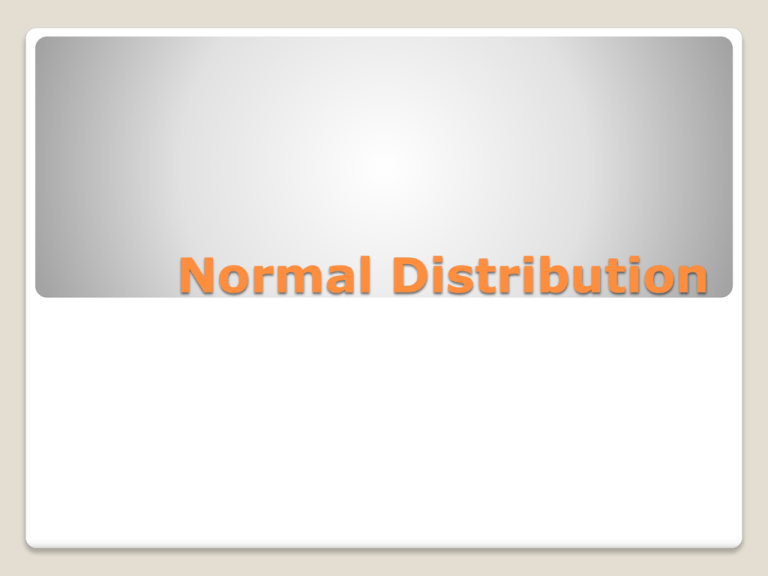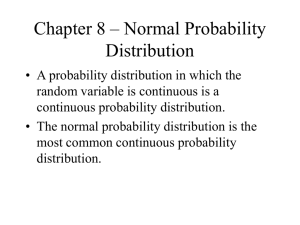Standard Normal Distribution
advertisement

Normal Distribution A lot of our real life experience could be explained by normal distribution. Normal distribution is important for statisticians for some other reasons. The mean and variance/standard deviation make more sense. Different ways of calculating probability. Normal Distribution PDF: 1 f ( x) e 2 ( x )2 2 2 = mean = standard deviation =3.14159 e =2.71828 Normal distribution The parameters of normal distribution: and Shape: pdf and cdf. Normal distribution What can we say about the shape of the bell curve? ◦ ◦ ◦ ◦ 1. 2. 3. 4. Bell shaped. Symmetric about the mean. The highest point is the mean. The tails are thin. Normal distribution What the parameters mean to us? ◦ Mean: Location of the center of the bell curve. If mean increases, the curve shifts to the right. If mean decreases, the curve shifts to the left. ◦ Standard deviation: Shape of the bell curve (flat?, wide?, tall?) Normal Distribution What else can standard deviation tell us? Actually, the standard deviation of normal distribution can tell us a lot more than the standard deviations of other distributions. Normal distribution If we have a random variable that follows a normal distribution, then: ◦ 68.3% of its values fall within ONE standard deviation. ◦ 95.4% of its values fall within TWO standard deviations. ◦ 99.7% of its values fall within THREE standard deviations. Normal distribution Given a random variable, X, with mean and standard deviation , we can create a standardized version of this random variable: x ◦ ◦ If we do this to a normally distributed random variable, we get a standard normal random variable. ◦ Usually, we use the letter Z to represent it. Standard Normal Distribution The standardized normal random variable, Z, follows a standard normal distribution. Regardless of the original mean and variance for X, the one before standardization, the mean and standard deviation of Z are: and 0 1 Standard Normal Distribution The pdf for Z is: Therefore, whenever we talk about standard normal distribution, we know both its functional form and its parameters. f (Z ) 1 e 2 z2 2 Standard Normal Distribution For any random variable, we need to know ◦ ◦ ◦ ◦ 1. 2. 3. 4. How How How How is it defined? can it be used? to find probability under it? to find its mean and variance? Think about how to find probability under normal distribution. What is the use of standard normal? 1. If we use the formula for mean and variance: xf ( x)dx ( x ) f ( x)dx 2 2 That is hard!!! Standard normal distribution 2. Another way of finding probability under normal distribution, using CDF. NOT CDF of any normal random variable, but CDF of a standard normal random variable. This function is usually denoted as: And that is defined as ( Z ) ( Z 0 ) P( Z Z 0 ) Standard Normal Distribution Some probabilities under standard normal distribution: P(Z<1)= ? P(Z<0)=? P(Z>0)=? P(-1<Z<1)=? P(Z<-2)=? P(Z>3)=? Standard Normal Distribution Be prepared to draw plots! A tip to finding probability under normal distribution P(0<Z<0.5)=? P(1.5<Z<2.5)=? Probabilities like that can be found using standard normal probability table, or Z table. Appendix B in your textbook. Some other probabilities under standard normal distribution If we have a normal random variable, X, instead of standard normal random variable to start with, we can always standardize X to Z and look up the probability in the Z table. Example: X~N(5,4), find the probability P(X<13), P(X<8.6) and P(X<-3.5) Also, find P(2<X<9), P(X>10|X>3), P(X>10|X>5), P(X<8|X<3) and P(X<3|X<8) How about just a normal r.v.? A STAT301 midterm has a mean of 71 and standard deviation of 4.8. 1. What is the probability that someone’s grade is between 60 and 80? 2. What is the probability that someone’s grade is greater than 72? 3. What is the probability that someone’s grade is below 50? Example If half of the class is going to get A in the above course, so what will be the cutoff for A? This problem uses something we learned before, the percentile. This kind of problem can be solved using a different form of the standardization formula: In the formula, both and and the percentile is given by Z. X Z Example are given If 10% of students will get A, what is the cutoff? If 25% of students will get A, what is the cutoff? Example



